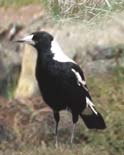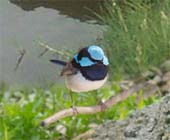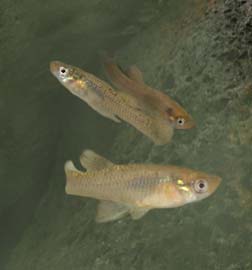Panel 5: Pobblebonk

The exhibition has been given the name Pobblebonk, which is the name of one of the several frog species once common to the Maribyrnong estuary and other similar areas in Victoria. The existence and survival of frogs is considered a measure of the health of the environment and there is concern about frogs worldwide. Although frogs are only one part of the complex environmental mix in the valley they can be seen as a key indicator of the health of this environment.
Animals

GREY-HEADED FLYING FOX
The Flying Fox or Fruit Bat, one of the largest bats in the world, is mainly active at night, navigating by sight and feeding on Eucalypt blossom and nectar, and fruits.

MAGPIE – barrawan

PELICAN – wadjil/ bardangal (B)

DUSKY MOOR HEN – kor rung un un

SUPERB BLUE WREN
The male has bright blue, black and white markings while the female is light brown.

Photograph by Kwai Chang-Kum, Werribee Zoo
THE POBBLEBONK FROG
The Pobblebonk frogs are solidly built and powerful jumpers and swimmers. The call is a short, musical explosive note producing a resonant ‘bonk’, usually repeated every few seconds.

!! MOSQUITO FISH !! – DANGER DANGER
This is the only non-indigenous animal in our exhibition (not originally from the Maribyrnong River Estuary). The reason we have included it is because it presents a serious danger to the whole wetland and food web system. Mosquito Fish, native to North America, were introduced in the 1920’s to control mosquitoes but instead have threatened several indigenous fish species and are also thought to be partly responsible for the decline of frogs through eating frogspawn and tadpoles. Mosquito fish are sometimes also known as guppies and are often kept as pets in goldfish bowls, they are very easy to breed. The problem with this is that they are sometimes ‘set -free’ by well-meaning owners into wetlands and river systems where the mosquito fish quickly multiplies and threatens the indigenous fish and frog species. They are very difficult to get rid of once they have entered these systems.
Images of each of the animals in this exhibition are available to purchase in a high-resolution format. All enquiries should be directed to admin@livingmuseum.org.au or by telephone on +613 9318 3544.
